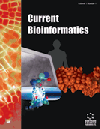- Home
- A-Z Publications
- Current Bioinformatics
- Previous Issues
- Volume 14, Issue 3, 2019
Current Bioinformatics - Volume 14, Issue 3, 2019
Volume 14, Issue 3, 2019
-
-
Protein Inter-Residue Contacts Prediction: Methods, Performances and Applications
More LessAuthors: Xiaoyang Jing, Qimin Dong, Ruqian Lu and Qiwen DongBackground: Protein inter-residue contacts prediction play an important role in the field of protein structure and function research. As a low-dimensional representation of protein tertiary structure, protein inter-residue contacts could greatly help de novo protein structure prediction methods to reduce the conformational search space. Over the past two decades, various methods have been developed for protein inte Read More
-
-
-
A Review on the Recent Developments of Sequence-based Protein Feature Extraction Methods
More LessBackground: Proteins play a crucial role in life activities, such as catalyzing metabolic reactions, DNA replication, responding to stimuli, etc. Identification of protein structures and functions are critical for both basic research and applications. Because the traditional experiments for studying the structures and functions of proteins are expensive and time consuming, computational approaches are highly desired. In ke Read More
-
-
-
The Recent Applications and Developments of Bioinformatics and Omics Technologies in Traditional Chinese Medicine
More LessBackground: Traditional Chinese Medicine (TCM) is widely utilized as complementary health care in China whose acceptance is still hindered by conventional scientific research methodology, although it has been exercised and implemented for nearly 2000 years. Identifying the molecular mechanisms, targets and bioactive components in TCM is a critical step in the modernization of TCM because of the complexity and uniq Read More
-
-
-
A Survey on Computational Methods for Essential Proteins and Genes Prediction
More LessAuthors: Ming Fang, Xiujuan Lei and Ling GuoBackground: Essential proteins play important roles in the survival or reproduction of an organism and support the stability of the system. Essential proteins are the minimum set of proteins absolutely required to maintain a living cell. The identification of essential proteins is a very important topic not only for a better comprehension of the minimal requirements for cellular life, but also for a more efficient discovery of the hu Read More
-
-
-
The Computational Prediction Methods for Linear B-cell Epitopes
More LessAuthors: Cangzhi Jia, Hongyan Gong, Yan Zhu and Yixia ShiBackground: B-cell epitope prediction is an essential tool for a variety of immunological studies. For identifying such epitopes, several computational predictors have been proposed in the past 10 years. Objective: In this review, we summarized the representative computational approaches developed for the identification of linear B-cell epitopes. Methods: We mainly discuss the datasets, feature extraction metho Read More
-
-
-
A Brief Survey of Machine Learning Methods in Protein Sub-Golgi Localization
More LessAuthors: Wuritu Yang, Xiao-Juan Zhu, Jian Huang, Hui Ding and Hao LinBackground: The location of proteins in a cell can provide important clues to their functions in various biological processes. Thus, the application of machine learning method in the prediction of protein subcellular localization has become a hotspot in bioinformatics. As one of key organelles, the Golgi apparatus is in charge of protein storage, package, and distribution. Objective: The identification of protein location in Golgi appar Read More
-
-
-
Research Progress of Exogenous Plant MiRNAs in Cross-Kingdom Regulation
More LessAuthors: Hao Zhang, Mengping Zhan, Haowu Chang, Shizeng Song, Chunhe Zhang and Yuanning LiuBackground: Studies have shown that exogenous miRNAs have cross-kingdom regulatory effects on bacteria and viruses, but whether exogenous plant miRNAs are stable in human body or participate in cross-kingdom regulation is still controversial. Objective: This study aims to propose a new method for the presence and cross-kingdom regulation pathway of exogenous Plant miRNA, which combines biological calculations and Read More
-
-
-
A Review of DNA-binding Proteins Prediction Methods
More LessAuthors: Kaiyang Qu, Leyi Wei and Quan ZouBackground: DNA-binding proteins, binding to DNA, widely exist in living cells, participating in many cell activities. They can participate some DNA-related cell activities, for instance DNA replication, transcription, recombination, and DNA repair. Objective: Given the importance of DNA-binding proteins, studies for predicting the DNA-binding proteins have been a popular issue over the past decades. In this article, we review curr Read More
-
-
-
Data Integration of Hybrid Microarray and Single Cell Expression Data to Enhance Gene Network Inference
More LessAuthors: Wei Zhang, Wenchao Li, Jianming Zhang and Ning WangBackground: Gene Regulatory Network (GRN) inference algorithms aim to explore casual interactions between genes and transcriptional factors. High-throughput transcriptomics data including DNA microarray and single cell expression data contain complementary information in network inference. Objective: To enhance GRN inference, data integration across various types of expression data becomes an economic and effi Read More
-
-
-
A Novel Model for Predicting LncRNA-disease Associations based on the LncRNA-MiRNA-Disease Interactive Network
More LessAuthors: Lei Wang, Zhanwei Xuan, Shunxian Zhou, Linai Kuang and Tingrui PeiBackground: Accumulating experimental studies have manifested that long-non-coding RNAs (lncRNAs) play an important part in various biological process. It has been shown that their alterations and dysregulations are closely related to many critical complex diseases. Objective: It is of great importance to develop effective computational models for predicting potential lncRNA-disease associations. Method: Based on the hypot Read More
-
Volumes & issues
-
Volume 20 (2025)
-
Volume 19 (2024)
-
Volume 18 (2023)
-
Volume 17 (2022)
-
Volume 16 (2021)
-
Volume 15 (2020)
-
Volume 14 (2019)
-
Volume 13 (2018)
-
Volume 12 (2017)
-
Volume 11 (2016)
-
Volume 10 (2015)
-
Volume 9 (2014)
-
Volume 8 (2013)
-
Volume 7 (2012)
-
Volume 6 (2011)
-
Volume 5 (2010)
-
Volume 4 (2009)
-
Volume 3 (2008)
-
Volume 2 (2007)
-
Volume 1 (2006)
Most Read This Month
Article
content/journals/cbio
Journal
10
5
false
en


